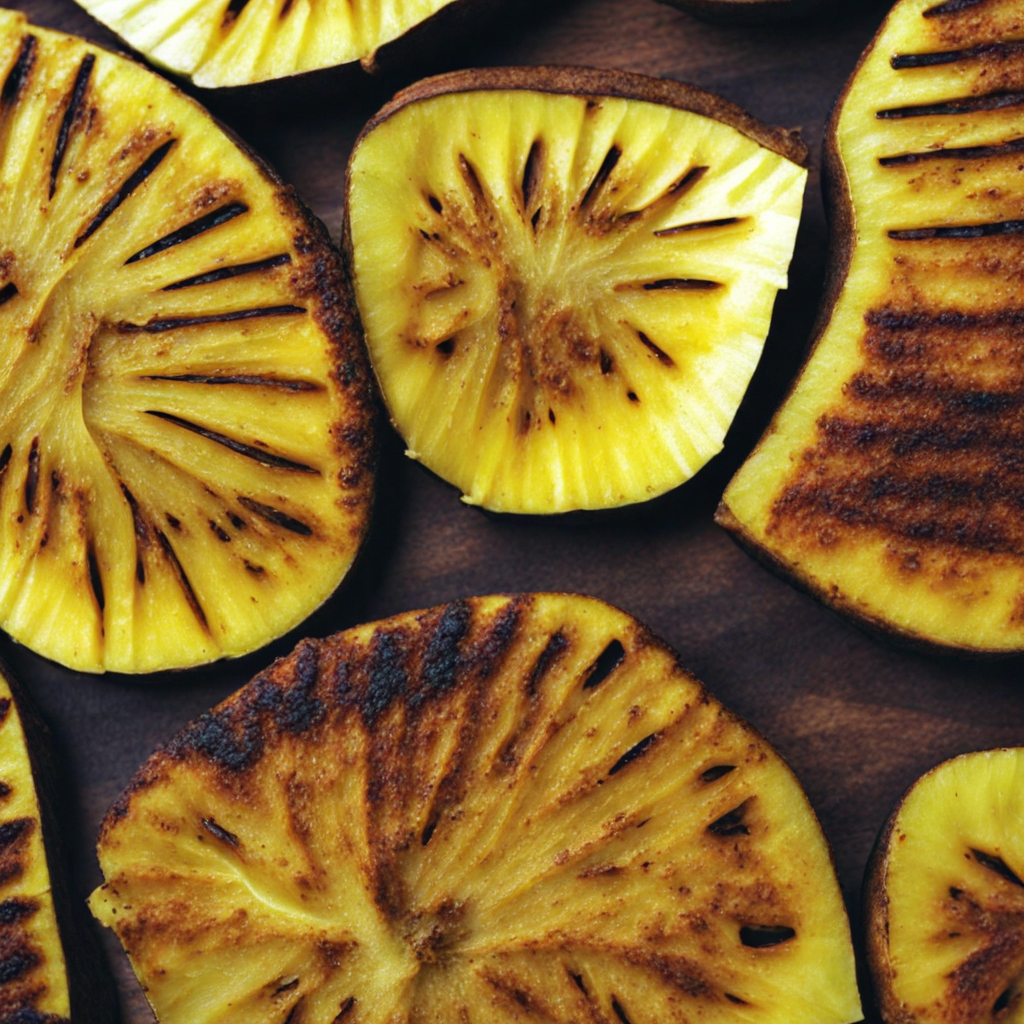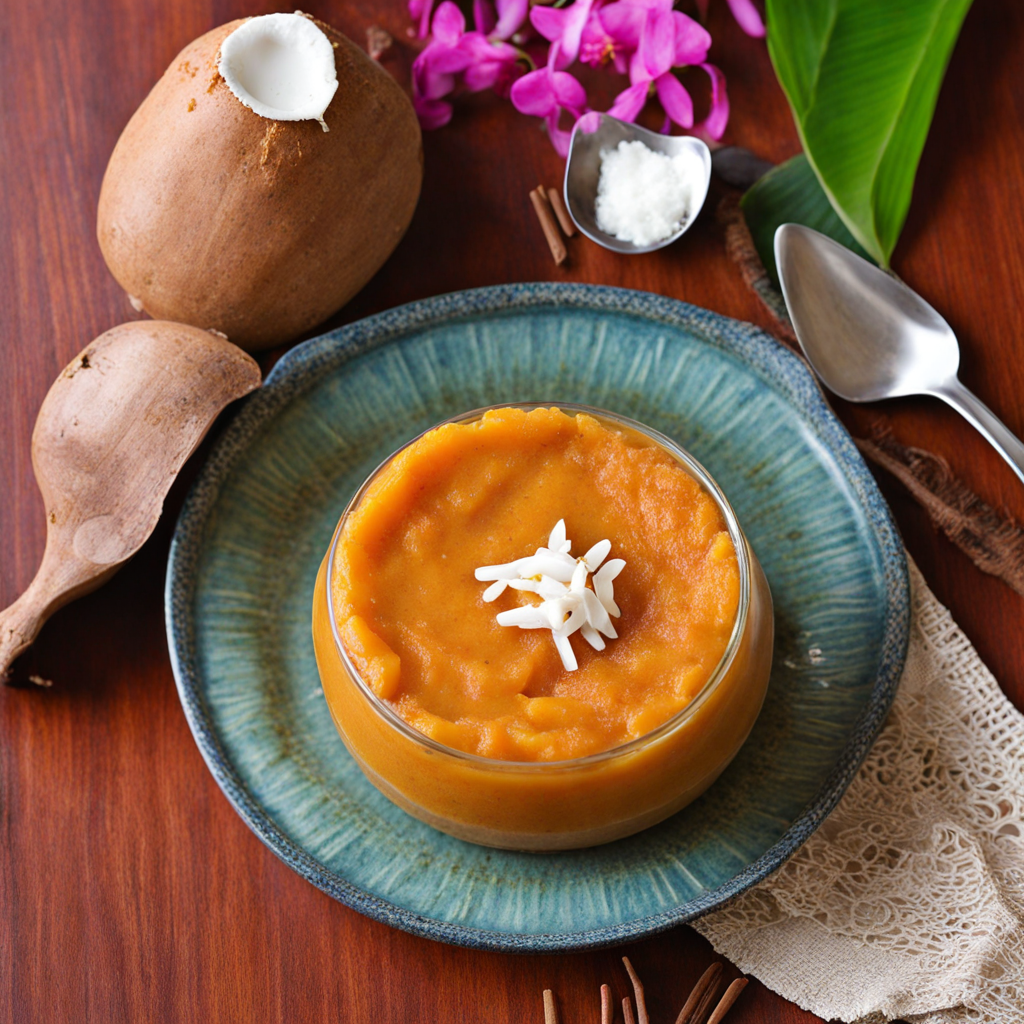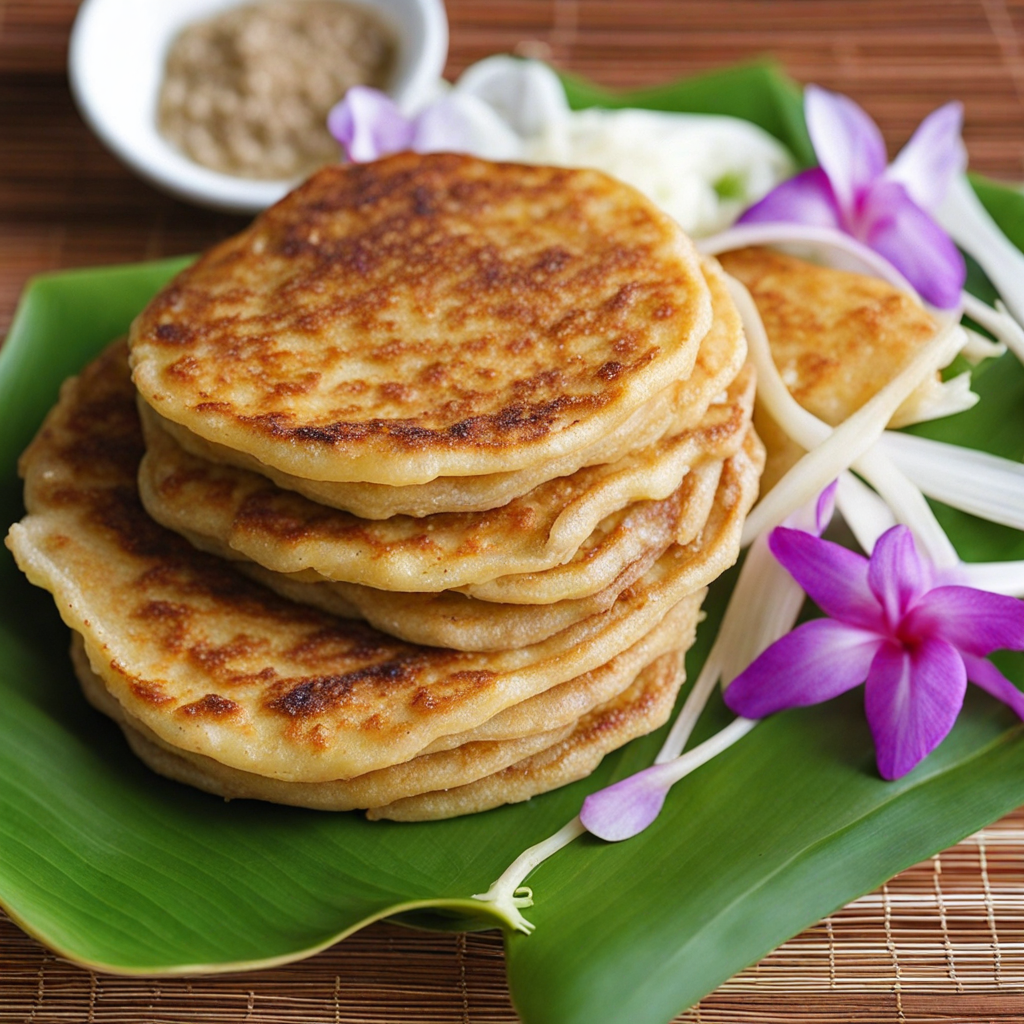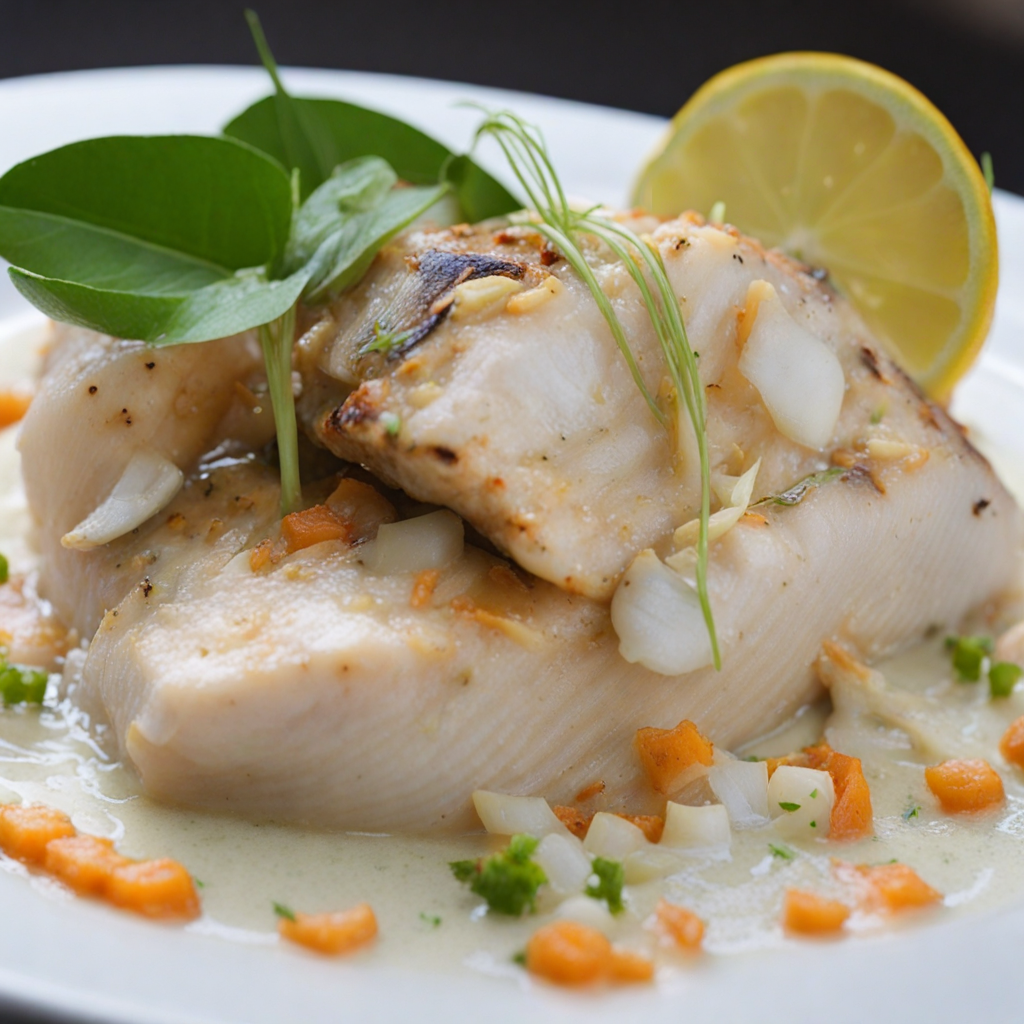Grilled Breadfruit
Grilled Breadfruit is a delightful culinary gem from Tuvalu, showcasing the island's rich tropical bounty. This starchy fruit, resembling a large green orb, offers a subtle sweetness and a creamy texture when cooked. When grilled, the breadfruit develops a beautifully charred exterior that enhances its natural flavors, creating a contrast with its soft, tender flesh. The grilling process caramelizes the sugars within, resulting in a smoky, slightly sweet aroma that beckons food lovers to indulge in its unique taste profile. Often enjoyed as a side dish or a standalone snack, Grilled Breadfruit is typically served warm, allowing the natural flavors to shine through. It can be seasoned simply with a sprinkle of sea salt or drizzled with coconut cream for an added layer of richness. In Tuvaluan cuisine, it is frequently paired with fresh seafood or local vegetables, making it an integral part of festive feasts and everyday meals alike. The versatility of grilled breadfruit means it can be enjoyed in various forms, whether cubed, sliced, or even mashed. The experience of savoring Grilled Breadfruit extends beyond its taste; it embodies the essence of Tuvaluan culture and the island's connection to nature. As you take your first bite, you will discover a harmony of flavors that reflects the simplicity and authenticity of island life. With each mouthful, the warm, earthy notes transport you to the sun-kissed shores of Tuvalu, making Grilled Breadfruit not just a dish, but a journey into the heart of the Pacific Islands.
How It Became This Dish
The History of Breadfruit Togi from Tuvalu: A Culinary Journey Origins of Breadfruit Breadfruit (Artocarpus altilis) is a tropical fruit that has played a vital role in the subsistence of numerous Pacific island communities for centuries. Believed to have originated in the Indo-Malay region, the tree was introduced to various Pacific islands by early Polynesian navigators, who recognized its value as a staple food. The breadfruit tree was well-suited for the tropical climate, thriving in the rich volcanic soils of islands across Oceania. Its fruit is known for its versatility, able to be consumed at various stages of ripeness, and its starchy texture resembles that of freshly baked bread when roasted or boiled. In Tuvalu, a small island nation in the central Pacific, breadfruit became an integral part of the traditional diet. The islands of Tuvalu, comprising nine atolls, are characterized by limited agricultural diversity due to their small land area and low-lying topography. As such, breadfruit emerged as a critical food source, providing sustenance and nourishment to the local population. Cultural Significance In Tuvaluan culture, breadfruit holds more than just nutritional value; it is woven into the very fabric of social and cultural life. The fruit is celebrated in various traditional ceremonies and gatherings, highlighting its importance in communal life. Breadfruit is often prepared for special occasions, such as weddings, birthdays, and feasts, symbolizing hospitality and the sharing of resources among families and communities. The practice of preparing 'Breadfruit Togi'—a traditional dish made from breadfruit—exemplifies this cultural significance. Togi is a method of cooking where the breadfruit is steamed or boiled and then mashed or pounded, often mixed with coconut cream or other local ingredients. This preparation reflects the resourcefulness of Tuvaluans, who utilize the island's natural bounty to create delicious and satisfying meals. The communal aspect of sharing breadfruit dishes is vital in fostering social bonds. During communal feasts, people gather to enjoy the flavors of breadfruit togi, which serves as a reminder of the importance of togetherness and collaboration in Tuvaluan society. The act of sharing food reinforces familial ties and community solidarity, reinforcing the idea that food is not just sustenance, but a means of connection. Development Over Time The journey of Breadfruit Togi in Tuvalu has evolved over time, influenced by historical events, colonization, and globalization. The introduction of Western culinary practices and ingredients in the 19th and 20th centuries brought about a shift in the traditional diet. While breadfruit remained a staple, its preparation and consumption began to incorporate new flavors and techniques. During the colonial period, Tuvalu was under the influence of both British and American administrations, leading to the introduction of new crops and food items. The arrival of canned goods, processed foods, and imported staples gradually altered local eating habits. However, the resilience of Tuvaluan culture ensured that traditional foods like breadfruit continued to be cherished. Breadfruit Togi adapted accordingly, with local cooks experimenting by adding new ingredients such as imported spices, meats, and dairy products, creating a fusion of flavors that still honors the essence of traditional preparations. The 20th century also saw significant changes in Tuvaluan society due to external factors such as climate change and globalization. The increasing vulnerability of island nations to rising sea levels and changing weather patterns posed challenges for local agriculture. In response, there has been a renewed interest in preserving traditional food practices and promoting food security through the cultivation of resilient crops like breadfruit. In recent decades, initiatives aimed at promoting sustainable agriculture and food sovereignty have gained traction. Local organizations and NGOs have worked to educate communities about the importance of traditional foods, including breadfruit. Efforts have been made to revitalize interest in breadfruit cultivation, ensuring its continued presence on Tuvaluan tables and in cultural practices. This resurgence reflects a growing awareness of the need to reconnect with local food systems and the wisdom of ancestral practices. Modern Adaptations and Global Recognition Today, Breadfruit Togi remains a cherished dish in Tuvalu, but its preparation has also adapted to modern tastes and global culinary trends. Chefs and home cooks alike have begun to explore innovative ways to present this traditional dish, incorporating global flavors while maintaining its cultural roots. The rise of food tourism has also brought attention to Tuvalu’s culinary heritage, with visitors eager to experience authentic dishes like Breadfruit Togi. Social media and food blogs have played a pivotal role in showcasing the beauty and richness of Tuvaluan cuisine. Pictures of beautifully plated Breadfruit Togi, often accompanied by vibrant local ingredients, have captured the interest of food enthusiasts worldwide. As a result, this once-local dish has gained visibility on the global stage, encouraging a cross-cultural exchange of culinary practices. Moreover, as the world becomes increasingly aware of the environmental sustainability of locally sourced foods, breadfruit has been recognized for its potential as a sustainable crop. Its ability to thrive in poor soil conditions and its minimal water requirements make it an appealing option in the context of global food security. Initiatives promoting the cultivation and culinary use of breadfruit are gaining momentum, inspiring chefs and farmers around the world to embrace this versatile ingredient. Conclusion The history of Breadfruit Togi in Tuvalu is a testament to the resilience and adaptability of a culture deeply rooted in its land and traditions. From its origins as a staple food to its status as a symbol of community and togetherness, Breadfruit Togi continues to evolve while honoring its rich heritage. As Tuvalu navigates the challenges of the modern world, the enduring presence of breadfruit in the local diet serves as a reminder of the importance of preserving culinary traditions and the connection to one’s cultural identity. In a world that often prioritizes rapid change, the journey of Breadfruit Togi showcases the beauty of culinary traditions that withstand the test of time, bridging generations and fostering a sense of belonging in the hearts of Tuvaluans. As we savor the flavors of this beloved dish, we not only taste the essence of Tuvalu but also celebrate the resilience of its people and their enduring connection to the land.
You may like
Discover local flavors from Tuvalu







